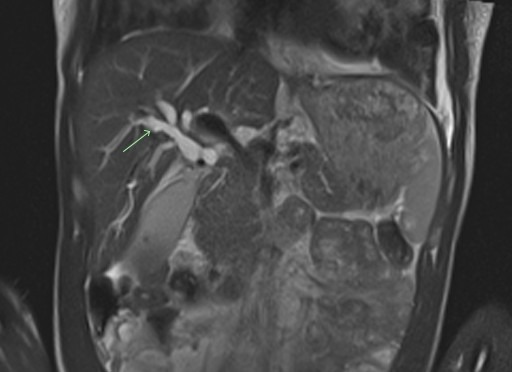Back

Poster Session C - Monday Afternoon
Category: Biliary/Pancreas
C0034 - AIDS Cholangiopathy Secondary to Kaposi Sarcoma: A Rare Presentation
Monday, October 24, 2022
3:00 PM – 5:00 PM ET
Location: Crown Ballroom


Joseph J. Alukal, MD
Valley Health System
Las Vegas, NV
Presenting Author(s)
Ejo John, MD1, Stan Abraham, MD2, Mohammed Hoque, MD1, Joseph J. Alukal, MD1
1Valley Health System, Las Vegas, NV; 2Father Muller Medical College, Kerala, Kerala, India
Introduction: AIDS cholangiopathy occurs in the setting of advanced immunosuppression in HIV patients and is caused by opportunistic pathogens such as Cryptosporidium and Cytomegalovirus( CMV). Although hepatic and GI tract involvement due to Kaposi sarcoma (KS) is a known entity, cholangiopathy involving the biliary tree is extremely rare and is sparsely reported in the literature.
Here, we present a case of an immunocompromised patient with biopsy-proven KS of the bile duct.
Case Description/Methods: A 39-year-old male with a known history of HIV/AIDS presented to the ER with right upper quadrant abdominal pain ongoing for 2 weeks. He also reported significant weight loss and loss of appetite. Vital signs on presentation were unremarkable and examination revealed mild tenderness of the RUQ and enlarged right axillary lymph nodes. The pertinent laboratory panel included total bilirubin of 2.5 mg/dL, alkaline phosphatase of 1883 U/L, AST 329 U/L, ALT 312 U/L, INR 1.0, and CD4 count of 15 cells/μL. Home medications included bictegravir/emtricitabine/tenofovir( Biktarvy) which was started approximately 6 weeks before hospitalization.
MRCP showed dilation of intra-hepatic and hepatic ducts with possible filling defects in the common bile duct. ERCP with cholangiogram demonstrated severely dilated CBD measuring up to 14 mm and stricture of hepatic ducts which were cannulated using a 10 French stent. FNA of the biliary structures revealed Human Herpesvirus-8 (HHV-8) consistent with Kaposi Sarcoma.
Discussion: AIDS cholangiopathy is characterized by infection of the biliary tract by opportunistic organisms resulting in strictures and obstruction. The most frequent organisms implicated in HIV cholangiopathy include Cryptosporidium, CMV, Microsporidium, and Mycobacterium Avium. Cholangiopathy resulting from KS in the era of ART is an uncommon presentation and usually involves the liver, but very rarely the biliary tree.
Cholangiopathy usually manifests as vague abdominal discomfort, markedly high levels of serum alkaline phosphatase ( > 1000 U/L), and near-normal bilirubin levels. Four patterns of cholangiopathy have been described: 1) papillary stenosis, 2) sclerosing cholangitis, 3) combination of the two and 4) extra-hepatic strictures. Management involves imaging modalities such as MRCP and therapeutic interventions with ERCP to obtain bile duct brushing and possible sphincterotomy. It is also of paramount importance to initiate and maintain ART. Our patient most likely developed KS due to non-adherence to ART.

Disclosures:
Ejo John, MD1, Stan Abraham, MD2, Mohammed Hoque, MD1, Joseph J. Alukal, MD1. C0034 - AIDS Cholangiopathy Secondary to Kaposi Sarcoma: A Rare Presentation, ACG 2022 Annual Scientific Meeting Abstracts. Charlotte, NC: American College of Gastroenterology.
1Valley Health System, Las Vegas, NV; 2Father Muller Medical College, Kerala, Kerala, India
Introduction: AIDS cholangiopathy occurs in the setting of advanced immunosuppression in HIV patients and is caused by opportunistic pathogens such as Cryptosporidium and Cytomegalovirus( CMV). Although hepatic and GI tract involvement due to Kaposi sarcoma (KS) is a known entity, cholangiopathy involving the biliary tree is extremely rare and is sparsely reported in the literature.
Here, we present a case of an immunocompromised patient with biopsy-proven KS of the bile duct.
Case Description/Methods: A 39-year-old male with a known history of HIV/AIDS presented to the ER with right upper quadrant abdominal pain ongoing for 2 weeks. He also reported significant weight loss and loss of appetite. Vital signs on presentation were unremarkable and examination revealed mild tenderness of the RUQ and enlarged right axillary lymph nodes. The pertinent laboratory panel included total bilirubin of 2.5 mg/dL, alkaline phosphatase of 1883 U/L, AST 329 U/L, ALT 312 U/L, INR 1.0, and CD4 count of 15 cells/μL. Home medications included bictegravir/emtricitabine/tenofovir( Biktarvy) which was started approximately 6 weeks before hospitalization.
MRCP showed dilation of intra-hepatic and hepatic ducts with possible filling defects in the common bile duct. ERCP with cholangiogram demonstrated severely dilated CBD measuring up to 14 mm and stricture of hepatic ducts which were cannulated using a 10 French stent. FNA of the biliary structures revealed Human Herpesvirus-8 (HHV-8) consistent with Kaposi Sarcoma.
Discussion: AIDS cholangiopathy is characterized by infection of the biliary tract by opportunistic organisms resulting in strictures and obstruction. The most frequent organisms implicated in HIV cholangiopathy include Cryptosporidium, CMV, Microsporidium, and Mycobacterium Avium. Cholangiopathy resulting from KS in the era of ART is an uncommon presentation and usually involves the liver, but very rarely the biliary tree.
Cholangiopathy usually manifests as vague abdominal discomfort, markedly high levels of serum alkaline phosphatase ( > 1000 U/L), and near-normal bilirubin levels. Four patterns of cholangiopathy have been described: 1) papillary stenosis, 2) sclerosing cholangitis, 3) combination of the two and 4) extra-hepatic strictures. Management involves imaging modalities such as MRCP and therapeutic interventions with ERCP to obtain bile duct brushing and possible sphincterotomy. It is also of paramount importance to initiate and maintain ART. Our patient most likely developed KS due to non-adherence to ART.

Figure: MRI abdomen with contrast showed dilation of intrahepatic bile ducts and possible filling defects in the common bile duct.
Disclosures:
Ejo John indicated no relevant financial relationships.
Stan Abraham indicated no relevant financial relationships.
Mohammed Hoque indicated no relevant financial relationships.
Joseph Alukal indicated no relevant financial relationships.
Ejo John, MD1, Stan Abraham, MD2, Mohammed Hoque, MD1, Joseph J. Alukal, MD1. C0034 - AIDS Cholangiopathy Secondary to Kaposi Sarcoma: A Rare Presentation, ACG 2022 Annual Scientific Meeting Abstracts. Charlotte, NC: American College of Gastroenterology.
